Spirit Guardians of the Northwest Coast of Canada
The Haida Monumental Totem Poles
Article and photos by James
Michael Dorsey
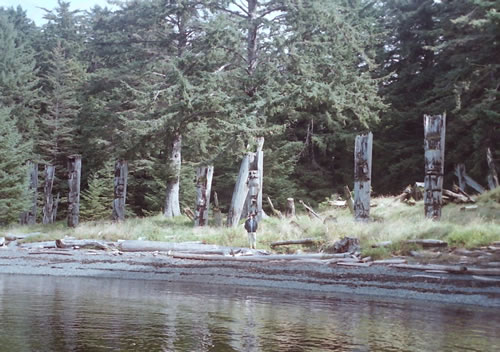
|
|
Author on Ninstints
beach with totems of the Haida Nation behind
him.
|
Many of humanity's greatest artistic
achievements are unknown to the world at large because their
creators never intended for the public to view them. Among
such largely unfamiliar accomplishments are the massive
totem carvings of the Haida people, which can be found on
a windswept island group 60 miles off the coast of British
Columbia, Canada.
|
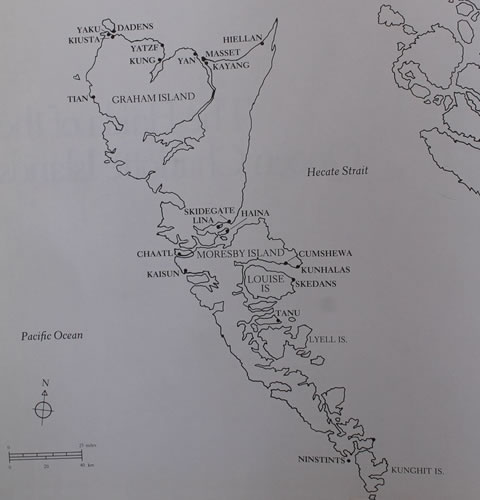
|
|
Map of the islands
of the Haida Gwaii, or "Land of the Haida," 60 miles
off the coast of British Columbia, Canada.
|
The totems watch over a sheltered cove
on the East Side of Anthony Island, at the ghost village
of Ninstints (or Skuun Gwaii, or Sung Gwaii; there are numerous
local spellings.) During my visit, 26 totem poles, with
but a handful in the world residing in their original location,
stood watch as the last mythological guardians of the Haida
Nation.
Now, this seems an appropriate time
to dispel a modern myth; American plains Indians never carved
a totem pole. Such mistaken images are yet another Hollywood
creation that originated in bad old "B movies." Totem
carving is specific to the Pacific Northwest. Most prolific
are the Haida, the native people of these islands, who carve
wood as easily as most of us breathe, and have an ancient
history rich in both art and warfare. The early people called
this land Xhaaidlagha Gwaayaai, or "Islands at the
Boundary of the World." The name has since been shortened
to Haida Gwaii, or "Land of the Haida." Most
of the world calls them by an earlier name — the Queen Charlotte
Islands. The islands number more than 1,800, and are part
of British Columbia, Canada. Their oral history can be traced
back 7,000 years. The earliest recorded information on these
islands comes from Spanish explorer, Juan Perez, who discovered
them in 1774. A decade later, Russian fur traders began
to frequent them and for the next century were the only
non-native visitors. The islands were given their British
name from the flagship of Lord Howe, the HMS Queen Charlotte,
who was the wife of King George III of England.
The totems watch over the land of the
ancestors as guardians, while also serving as both history
and literature. In Haida mythology, there are four premier
figures: Orca, Bear, Frog, and Raven. Of these, Raven takes
center stage since he is known as the trickster, always
trying to fool humankind. The Haida creation myth tells
of Raven pecking open a cockleshell to release the first
man into the world.
The story has been brought to life in
an epic carving by the northwest coast master, Bill Reid,
a descendant of Charles
Edenshaw, himself a Haida chief
named Tahayren, who later took the white name, Edenshaw.
These two men are generally acknowledged as among of the
finest carvers to ever live. Reid’s monumental carvings,
created mostly in stone, not only give life to ancient folk
tales but also rival in size and talent the early works
of such giants as Edenshaw. His finest examples may be found
in the courtyard of the Canadian Embassy in Washington D.C.
and at the Vancouver airport’s international terminal. Smaller
works by both Edenshaw and Reid now reside in some of the
world’s most prestigious museums. Today, contemporary Haida
artists carry on the tradition by carving not only wood,
but also argillite,
a dark and easily workable stone found only in a quarry
of these islands.
As a seafaring people, the Haida carved
enormous war canoes from a single cedar tree large enough
to carry dozens of warriors over 60 miles of open ocean
in order to raid and take slaves on the mainland. Their
warrior mentality earned them the title, “Vikings of the
north.” Initially, contact with white people resulted in
the introduction of metal from Russian fur traders. Metal
allowed the Haida to fashion new and more efficient tools,
increasing their skills tenfold. They carved wood on a monumental
scale. House columns, commemorative totems, burial boxes,
and even ornamental bowls were all of the highest order.
|
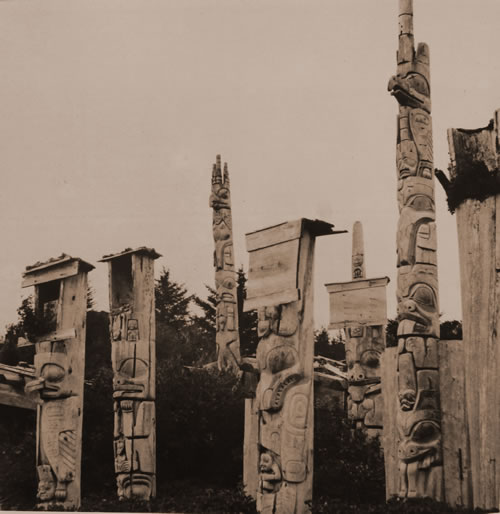
|
|
Old Ninstints funerary
poles.
|
Haida villages always occupied a shoreline.
The villages were surrounded by a protective midden of crushed
shells that served as a warning system against attack. The
shells outlined an intruder as a silhouette at night. At
the time, they made plenty of noise and served as an alert
when outsiders tried to sneak into their villages.
As late as the 19th century intertribal
warfare and raiding was common. Instances of ceremonial
cannibalism in which tiny pieces of the human flesh from
those vanquished in battle were consumed in order to add
the enemy's power to that of the warrior. Unfortunately,
such intertribal wars led to sensationalized news stories
attributing cannibalism to the Haida as a way of daily life,
even though that was simply not the reality.
In every Haida community, just up from
the midden’s waterline, row after row of monumental totems
told the story of the village and its history.
The poles lean now at various angles
and are deteriorating rapidly. Several funeral poles once
held wooden boxes with the remains of Haida nobles. The
early Haida buried their chiefs by packing their bodies
into tiny wooden boxes that were placed at the top of a
burial totem in front of the chief's lodge. The carvings
on the totem tell the story of significant events in the
man's life. No image is random. Each personage, whether
real or imagined, has a specific meaning: a wedding, a death,
or a great battle. The distorted faces and contorted body
positions of both man and beast on the totems suggest a
spirit world beyond the imagination of many modern people.
|
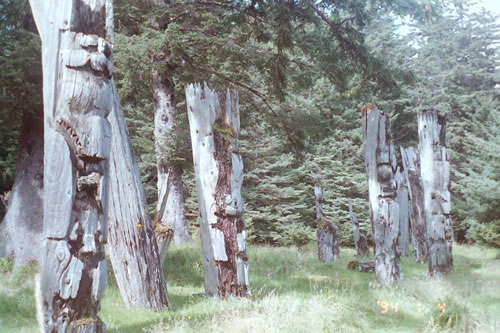
|
|
Line of many leaning
Haida totem poles.
|
At the apex of Haida culture, close
to 14,000 people occupied the islands with almost 300 living
in Ninstints. The village name is a western mispronunciation
of Nan Sdins, who was chief at the time of initial contact
with the white man. About 1860, small pox was introduced
by white fur traders and soon only about 30 people were
left alive at Ninstints. By 1911, the total native population
of all the islands stood at 589. Ninstints was totally abandoned
around 1880, but its exact date is lost to history.
Some native people believe a totem
should stand in nature until it is reclaimed by the earth.
Others have tried to save these poles for posterity. In 1995,
a large-scale restoration project was undertaken with the consent
of local Haida elders to prop up some of the poles in danger
of falling. A few have been relocated to museums. Originally,
there were 35 totems at Ninstints. At the time of my visit,
there were 26.
The old Haida villages were also always
guarded from attack by a watchman. This was an honored position
within the tribe. The watchmen were distinguished by wearing
a conical shaped hat made from cedar bark. Many of their
totems, including contemporary ones, are topped by carved
watchmen who stand guard. Today, the Haida people have reinstated
this program and each native site has an active watchman
on duty. Visitors must gain permission in advance before
landing on any of these beaches.
|
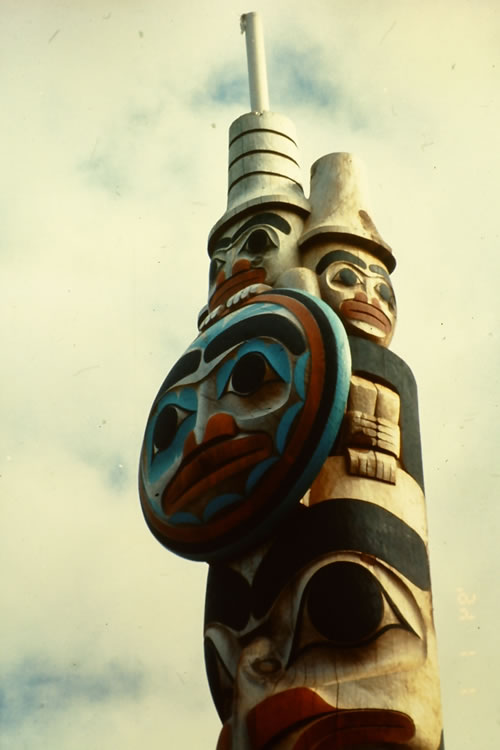
|
|
Modern Watchman
on totem.
|
In 1981, Ninstints
was declared a World Heritage Site by the UNESCO,
guaranteeing its preservation for the immediate future.
Unless these poles are removed, they will eventually
be reclaimed by time and weather, since they are organic.
For now, the remaining poles are a magnificent legacy
of a vanishing culture.
James Michael Dorsey is
an explorer, award winning author, photographer, and
lecturer. He has traveled extensively in 45 countries,
mostly far off the beaten path. His main pursuit
is visiting remote tribal cultures in Asia
and Africa.
|
